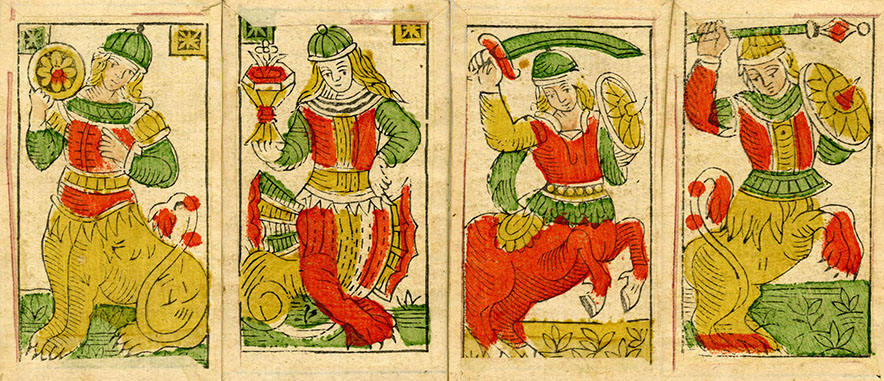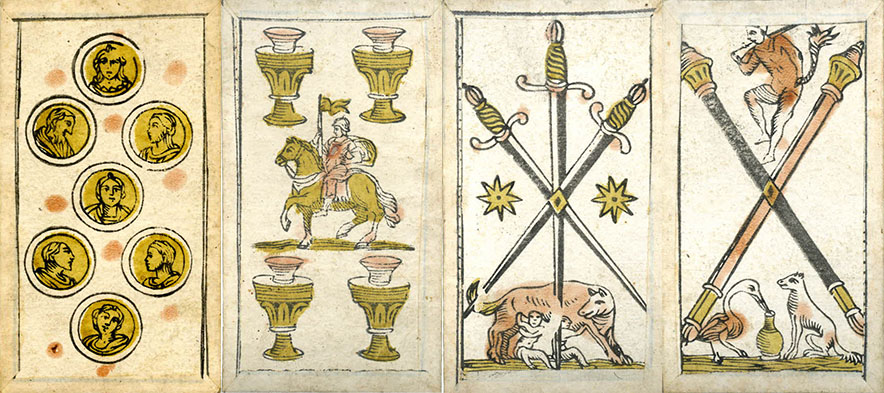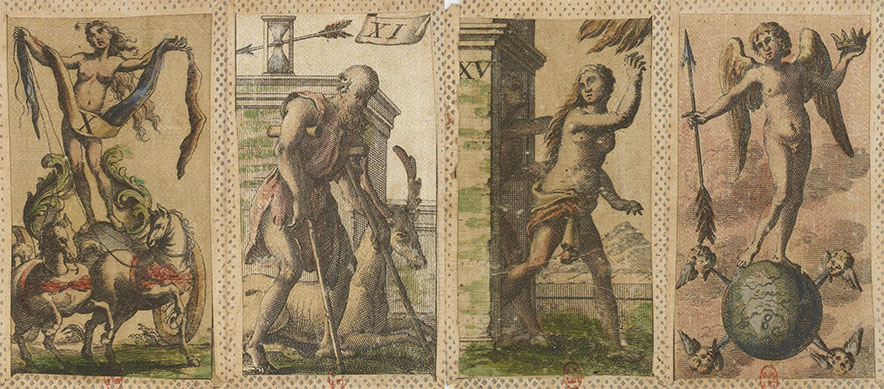THE TAROT WHEEL
THE MINCHIATE DECK
Like the Tarocchino deck, the Minchiate deck is a variation of the Tarocco (Tarot). But instead of removing cards, like in the Tarocchino decks, cards were added to the Minchiate decks. The changes are made in the Trump cards. The Popess was removed, but after the Devil 20 new Trumps were inserted; the four missing Virtues, the Four Elements and the twelve signs of the Zodiac. The order of the original Trumps is the same as for the Tarocchino deck. In the Minchiate deck, the cards numbered 1 to 5 are called the five Popes. The Fool and the five highest cards (from the Star to the Angel) are unnumbered.
The history of the Minchiate decks goes back at least to the 16th Century, and maybe further. In the 16th Century the Minchiate still had another name, it was called the Germini deck. In 1553, the Florentine Bartolomeo di Michelangelo published a poem, describing the forty trumps of the Germini deck. A translation of the Poem is available on the Taropedia site. For this reason, we believe that the origins of the Minchiate game are in Florence. The oldest surviving Florentine decks we have date from the 17th Century. Also in Bologna, Minchiate decks were produced, we know several decks, all dated to the 18th Century.
Many books have been written on the Minchiate decks, and searching the Internet for Minchiate will reveal much more information than I can give here. I'm not a Minchiate specialist, so the text and illustrations here below are only a brief introduction to this very peculiar cousin of the Tarot decks. The Minchiate decks have some particularities in common that make them easy recognizable. Some of them are listed here below
The Minchiate deck has twenty additional trumps when compared to a standard Tarot deck. Even if the four added Virtues appear in some decks, the four elements and the Zodiac signs do not appear in any other Tarot related deck. Here below as illustration, the four elements (respectively Fire, Water, Earth and Air), represented by an 18th Century deck made in Bologna.
The knights of the Minchiate decks are different from standard Tarot decks. They are half human and half animal. The animals are respectively a lioness on the suit of Coins, a griffin on the suit of Cups, a horse on the suit of Swords and a lion on the suit of Batons. The knights of Coins and Cups have a passive position and the knights of Swords and batons an active one. The example below is from a Minchiate deck made in 1823 in Rome.
Like on the Tarocchino cards, the Pages of Coins and Cups are girls and the Pages of Swords and Batons are boys. The girls have, like the knights of the corresponding suits, a passive position. The boys, in contrary, are in a fighting position. The examples are from a deck made in the 18th Century in Florence.
There are drawings on several pip cards. The cards illustrated below are from an early 18th Century deck from Bologna. The drawings on the Coins are also existing on the Tarocchino decks made by Mitelli, but the other drawings (that are especially abundant on the suit of Swords) are typical for the Minchiate decks.
Not even talking about the twenty additional trump cards, there are several typical cards, different from other decks of the Tarot family. Here below some typical examples. The deck is made in 1712 in Florence by a certain Giovan Francesco di Santi Molinelli. On the first card we see the Chariot, with a naked woman standing and guiding the horses. On the next card there is the Hermit, represented as a cripple old man, with in the background a deer, and an hourglass, pierced by an arrow. The Tower is represented by Eve, followed by Adam, being thrown out of Paradise. Finally, the World card is represented by a naked angel, standing on the World that is surrounded by the four winds blowing in the direction of the Earth.
By the end of the 16th Century, the regular Tarocco games with 78 cards had almost disappeared as a game in Italy. Only in Central Italy, the Tarot related Tarocchino and Minchiate games stayed popular. Other variations appeared later, like the Sicilian Tarot game (Tarocco Siciliano), that used Spanish suit symbols instead of Italian ones.






